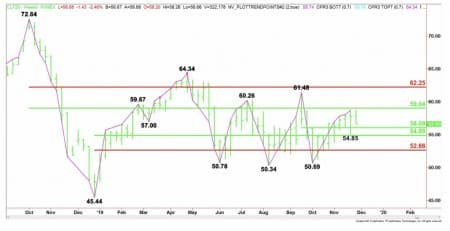U.S. West Texas Intermediate crude oil is trading lower early Friday on light post-holiday volume. Some traders are saying the move is in reaction to renewed tensions between the United States and China and increasing doubts the two economic powerhouses will reach a Phase One trade deal agreement before new U.S. tariffs kick in on December 15.
The two stories driving the price action throughout the month have been optimism over a U.S.-China trade deal, which helped dampen demand growth concerns, and the hope that OPEC and its allies would extend their production cuts into at least June 2020, which helped soften oversupply worries. For most of this holiday-shortened week, the key price drivers have been weekly inventories reports.
Inventory Reports at the Forefront
On Tuesday, the American Petroleum Institute (API) reported a crude oil inventory build of 3.639 million barrels for the week-ending November 22. Analysts were looking for a 418,000-barrel draw in inventory.
The API also reported a build of 4.378 million barrels of gasoline for the week-ending November 22, compared to analyst expectations of a smaller build in gasoline inventories of 1.222-million barrels for the week.
Distillate inventories saw a draw of 665,000 barrels for the week, while the futures hub at Cushing, Oklahoma fell by 516,000 barrels.
On Wednesday, the U.S. Energy Information Administration (EIA) reported a 1.6 million barrel build in U.S. crude stocks. Analysts were looking for a drop of 418,000 barrels.
The EIA also said U.S. gasoline inventories soared by 5.1 million barrels, compared with expectations for a 1.2 million-barrel gain.
Finally, according to the EIA, U.S. production hit a record high of 12.9 million barrels per day and refinery runs slowed.
Oil Drillers Reduce Number of Rigs
U.S. oil drillers reduced the number of drilling rigs for a record 12 months in a row, despite fresh production highs.
Drillers cut three oil rigs in the week to November 27, bringing the total count down to 668, the lowest since April 2017, energy services firm Baker Hughes Company said in data released two days early due to the U.S. Thanksgiving holiday on Thursday.
Trade Deal Optimism Persist but Doubts are Reemerging
The optimists are hanging on to the positive comments from Beijing and Washington. China’s Ministry of Commerce said Tuesday that negotiators from Washington and Beijing held another phone call to discuss how to “resolve core issues.” Trump followed up by saying that the U.S. and China are in the “final throes” of reaching a trade deal.
Despite the optimism, doubts over a timely trade deal are beginning to reemerge with prices being pressured by China’s warning to the United States on Thursday that it would take “firm countermeasures” in response to U.S. legislation backing anti-government protesters in Hong Kong. Related: In Pursuit Of The Perfect Fuel
Sellers are betting that any such move by China would further delay a preliminary agreement to end a U.S.-China trade war that has held global economic growth in check, while increasing worries over global demand growth.
Bullish Traders Hoping for Production Cut Extensions
Traders continue to expect OPEC and its allies, including Russia to agree to reduce output to support prices at their December 5-6 meeting. The broader producer group is widely expected to extend its 1.2 million-barrel-per-day supply cut to the middle of 2020.
Many traders feel that the group would have probably increased their output cuts had the U.S. and China not made progress in their trade talks. Analysts at J.P. Morgan believe the cuts may be extended until the end of 2020.
Technical Analysis
Weekly January West Texas Intermediate Crude Oil Technical Analysis

Trend Indicator Analysis
The main trend is up according to the weekly trend indicator chart, however, momentum is neutral. A trade through the September main top at $61.48 will signal a resumption of the uptrend. A move through $50.69 will change the main trend to down.
The minor trend is also up. A trade through $54.85 will change the minor trend to down. This will also shift momentum to the downside.
The main range is $72.64 to $45.44. Its 50% to 61.8% retracement zone at $59.04 to $62.25 is resistance. This zone stopped rallies at $60.26 and $61.48 in July and September, respectively. This week’s and last week’s highs fell short of the first resistance level at $59.04. This indicates that someone is stopping the rally.
The minor range is $45.44 to $64.34. Its retracement zone at $54.89 to $52.66 is support. Throughout September and October, traders established a support base inside this zone.
The short-term range is $61.48 to $50.69. This range was created in September/October. Its 50% level comes in at $56.09. With the current price at $56.47, the market has essentially gone nowhere over the past two months.
Weekly Forecast
Based on this week’s price action, the direction of the January WTI crude oil market the week-ending December 6 is likely to be determined by trader reaction to the short-term 50% level at $56.09.
Bullish Scenario
A sustained move over $56.09 will indicate the presence of buyers. If this move is able to generate enough upside momentum then look for a possible test of the main 50% level at $59.04. This is a potential trigger point for an acceleration to the upside with the next major targets a main top at $61.48 and the main Fibonacci level at $62.25.
Bearish Scenario
A sustained move under $56.09 will signal the presence of sellers. The first downside target is a potential support cluster at $54.89 to $54.85. The latter is a potential trigger point for an acceleration to the downside with the next target the minor Fibonacci level at $52.66.
Weekly Summary
January WTI crude oil is trapped between a pair of 50% levels at $54.89 and $59.04. It’s been this way since the week-ending October 25. This suggests investors are holding prices in range as they await news on the progress of U.S.-China trade negotiations and OPEC+’s decision to extend output cuts.
This market is not likely to deviate too far from $54.89 until there is fresh news over production cuts or a trade deal. The U.S.-China news will carry the most weight.
By Tom Kool for Oilprice.com
More Top Reads From Oilprice.com:
- U.S. Rig Count Crashes Again: Loses Nearly 100 Rigs In 3 Months
- Could The Aramco IPO Kill OPEC?
- Forget Tesla, This Is The Most Impressive Electric Vehicle Of The Year



















However, the trade war is not principally about oil or China’s trade surplus and alleged Chinese malpractices. It is about the petro-yuan undermining the supremacy of the petrodollar and by extension the US financial system, Taiwan, refusal by China to comply with US sanctions against Iran and Venezuela, China’s overwhelming dominance in the Asia-Pacific region and its sovereignty claim over 90% of the South China Sea, the new order in the 21st century and above all fear of the US losing its unipolar status.
President Trump’s bizarre behaviour and his reneging on what he says from day to day are squarely behind the alternating moods of the global oil market between optimism and pessimism.
One day he gets the global economy excited by saying that the U.S. and China are in the “final throes” of reaching a trade deal and the following day he is threatening to slap new tariffs on Chinese exports thus deflating the economy. Another day he praises Chinese President Xi Jinping to be followed almost immediately with signing a legislation supporting the demonstrators in Hong Kong. This is the behaviour of somebody with limited intellect and inability to see the wider picture.
His support of Hong Kong opposition is not only a blatant interference in China’s internal affairs but is also a crude ploy to shift global media focus away from his impeachment proceedings. China will retaliate. Moreover, this will harden its attitude towards ending the trade war. Having already won the war, China could afford to outwait the US in the war. China’s calculations are that the adverse impact of the war on the US economy coupled with the impeachment proceedings could cost President Trump the 2020 presidential elections.
However, it is very probable that President Trump will eventually swallow his pride and end the trade war against China if only to improve his chances of getting four more years in the White House.
OPEC + can only agree to extend the current production cuts by a few months but it will never agree to deepen them because such a measure is futile while the trade war is going on as it ends up losing market share with no positive impact on prices. Furthermore, Russia will never agree to that.
Dr Mamdouh G Salameh
International Oil Economist
Visiting Professor of Energy Economics at ESCP Europe Business School, London